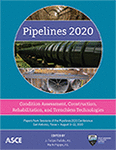Pipelines 2020
Forecasting Pipeline Construction Costs Using Time Series Methods
Publication: Pipelines 2020
ABSTRACT
Pipe and labor costs constitute about seventy percent of pipeline project costs. The accurate prediction of pipe and labor costs is invaluable for cost estimation of capital pipeline projects by helping to eliminate or at least reduce cost under- or over-estimations. The research objective of this paper is to develop and compare various time series methods to forecast pipe and labor costs. The 20-city average pipe and labor costs from 1995 to 2016 published monthly by Engineering News-Record (ENR) were used to develop the time series models. The accuracies of these forecasting models were evaluated using ENR pipe and labor cost data from 2017 to 2019. The results show that predictions with seasonal autoregressive integrated moving average (ARIMA) models are more accurate than those with the other models, such as Holt exponential smoothing. The results contribute to pipeline construction community by helping cost estimators to prepare more accurate bids for pipeline projects.
Get full access to this article
View all available purchase options and get full access to this chapter.
REFERENCES
Abediniangerabi, B., Shahandashti, S. M., Ahmadi, N., & Ashuri, B. (2017). “Empirical investigation of temporal association between architecture billings index and construction spending using time-series methods”. Journal of Construction Engineering and Management, 143(10), 04017080.
Abediniangerabi, B., Ahmadi, N., & Shahandashti, M. (2018). “Is Architectural Billing Index Helpful to Explain Fluctuations in Non-residential Construction Spending in the United States?.” In Construction Research Congress 2018 (pp. 19–28).
Ahmadi, N., & Shahandashti, M. (2017). “Comparative empirical analysis of temporal relationships between construction investment and economic growth in the United States.” Construction Economics and Building, 17(3), 85.
Ashuri, B., Shahandashti, S. M., & Lu, J. (2012a). “Empirical tests for identifying leading indicators of ENR construction cost index.” Construction Management and Economics, 30(11), 917–927.
Ashuri, B., Shahandashti, S., and Lu, J. (2012b). “Is the information available from historical time series data on economic, energy, and construction market variables useful to explain variations in ENR construction cost index?” Construction Research Congress 2012, ASCE, Reston, VA, 457–464.
Ashuri, B., & Shahandashti, S. M. (2012). “Quantifying the relationship between construction cost index (CCI) and macroeconomic factors in the United States.” In Proceedings of the 48th ASC Annual International Conference, Birmingham City University, Birmingham, April 11 (Vol. 14).
Brockwell, P. J., and Davis, R. A. (2002). Introduction to time series and forecasting, 2nd Ed., Springer, New York.
Dickey, D.A. and Fuller, W.A. (1979). “Distribution of the estimators for autoregressive time series with unit roots.” Journal of the American Statistical Association, 74, 427–431.
Faghih, S. A. M., & Kashani, H. (2018). Forecasting construction material prices using vector error correction model. Journal of Construction Engineering and Management, 144(8), 04018075.
Flyvbjerg, B. Skamris, M.K. and Buhl, S. L. (2003). “How common and how large are cost overrun in transport infrastructure projects?” Transp. Rev, Vol 23 (1), pp. 71–88.
Goh, B.H. and Teo, H.P. (2000). “Forecasting construction industry demand, price and productivity in Singapore: the Box-Jenkins approach.” Construction Management and Economics, 18, 607–618.
Hwang, S., Park, M., Lee, H. S., and Kim, H. (2012). “An automated time-series cost forecasting system for construction materials.” J. Constr. Eng. Manage., https://doi.org/10.1061/(ASCE)CO.1943-7862.0000536, 1259–1269.
Ilbeigi, M., B. Ashuri, and A. Joukar. (2016). “Time-series analysis for forecasting asphalt-cement price.” J. Manage. Eng.33 (1): 04016030.
Kirchgässner, G., and Wolters, J. (2007). Introduction to Modern Time Series Analysis. New York, NY: Springer.
Ljung, G. and Box, G. (1978). “On a Measure of Lack of Fit in Time Series Models”, Biometrika, 65, 297–303.
Memon, A. H., Abdul Rahman, I., and Abdul Azis, A. A. (2011). “Preliminary Study on Causative Factors Leading to Construction Cost Overrun.” International Journal of Sustainable Construction Engineering and Technology, 2(1).
Merrow, E. W., McDonnell, L., and Arguden, R. Y. (1988). “Understanding the outcomes of megaprojects: A quantitative analysis of very large civilian projects”. The RAND Corporation.
Rui, Z., Metz, P. A., Reynolds, D. B., Chen, G., and Zhou, X. (2011). “Historical pipeline construction cost analysis.” International Journal of Oil, Gas and Coal Technology, 4(3).
Rui, Z., Metz, P. A., and Chen, G. (2012). “An analysis of inaccuracy in pipeline construction cost estimation.” International Journal of Oil, Gas and Coal Technology, 5(1).
Said, E. S., and Dickey, D. A. (1984). “Testing for unit roots in autoregressive-moving average models of unknown order.” Biometrika, 71(3), 599–607.
Shahandashti, S. M., and Ashuri, B. (2013). “Forecasting engineering news-record construction cost index using multivariate time series models.” J. Constr. Eng. Manage., 10.1061, 1237–1243.
Shahandashti, S. M. (2014). “Analysis of construction cost variations using macroeconomic, energy and construction market variables.” Doctoral dissertation, Georgia Institute of Technology.
Shahandashti, S. M., and Ashuri, B. (2016). “Highway construction cost forecasting using vector error correction models.” J. Manage. Eng. 32 (2): 04015040.
Shumway, R. H., and Stoffer, D. S. (2017). Time Series Analysis and Its Applications. New York, NY: Springer.
Watson, P. K., and Teelucksingh, S.S. (2002). “A practical introduction to econometric methods: Classical and modern.” Univ. of the West Indies Press, Kingston, Jamaica.
Winters, P. R. (1960). “Forecasting sales by exponentially weighted moving averages.” Manage. Sci., 6, 324–342.
Information & Authors
Information
Published In
Pipelines 2020
Pages: 198 - 209
Editors: J. Felipe Pulido, OBG, Part of Ramboll and Mark Poppe, Brown and Caldwell
ISBN (Online): 978-0-7844-8320-6
Copyright
© 2020 American Society of Civil Engineers.
History
Published online: Aug 6, 2020
Published in print: Aug 6, 2020
Authors
Metrics & Citations
Metrics
Citations
Download citation
If you have the appropriate software installed, you can download article citation data to the citation manager of your choice. Simply select your manager software from the list below and click Download.
